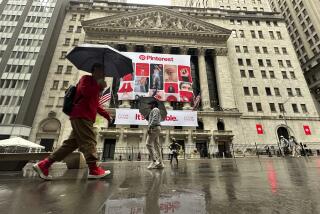High Interest Sets Course for a Big Chill
- Share via
The prevailing wisdom is inviting everyone to believe that the way to put out inflationary fires in the economy is to spray them with high interest rates. Prevailing wisdom, unfortunately, goes wrong when it jumps to conclusions based on simplistic thinking. This is easier to do than sorting out hard evidence; and in today’s cliche-ridden era, it’s the way policies are made.
But authorities rushing to fight inflation by raising interest rates have found the cure worse than the complaint. At best, the remedy strengthens the cost pressures that intensify inflation. At worst, the high-interest-rate strategy substitutes the chill of deflation for the heat of inflation.
Before inflation became a popular threat, automation provoked exaggerated fears of unemployment. Instead, the employment of capital multiplied and, consequently, money costs superseded labor costs as the trend-making factor. Nonetheless, the monetary authorities still operate in dread of an inflationary spiral of labor costs. Though that didn’t materialize, they have driven up money costs enough to trigger an inflationary explosion, if anything could.
Deflation takes over from inflation as the prevailing trend whenever incomes lag debt. Income stagnation would be hard for the country to take if debts were low and falling. But levels of debt are so high that payments to creditors have deflated discretionary spending on goods and services since Thanksgiving. The Federal Reserve Board declared war on inflation after deflation had already started to smother it.
As a practical matter, America has reacted to its loss of competitive clout by a growing susceptibility to wishful thinking and theorizing. The high-interest remedy against inflation was an early starter. The United States spent most of the 1960s fighting an off-budget war that whipped up an inflationary backlash against the economy. Ironically, a vigorous debate was going on at the time over whether raising interest rates was the way to stop inflation. When the war ended so did the debate.
Official confusion over where the economy is being pushed has sharpened the tendency to bring anti-inflationary code words into play. One outright deflationary development after another was being offered to the public as signs of progress toward “lower rates of inflation.” This cliche is a soporific for skepticism.
Party political differences present no problems. In matters of economic policy, bipartisanship is a fact, substituting Administration management for cross-examination or even modest debate. The Administration hardly has to ask for support to receive it from an opposition brain-washed for eight years by the poll ratings of Reaganomics.
Conclusive tests of performance by the economy as a whole are rare, but one does exist for judging the value of high interest rates as a preventive against inflation. It’s as simple as the litmus paper test for differentiating between acids and non-acids.
When the economy is spiraling into a bona fide inflation, all producers routinely put a mark-up on their costs--especially on their interest costs--and load them onto their customers; consumers wind up with the tab and ready to pay far more. So long as money chases goods, any cost increases add fuel to the fire, none more so than those due to borrowing. Loans aggravate the trouble by creating new money to chase supplies of goods limited during inflationary storms by the irresistible incentive to overbuy in order to hoard.
Like the litmus-paper test in the laboratory, the inflation test for interest rates in the marketplace also yields clear results. The marketplace is now providing plain evidence of a tilt from inflation to deflation, as producers no longer dare pass their cost increases on to customers. Consumers are refusing to buy new cars, even at penny-ante or zero-interest rates. Backlogs of unsold homes are stacking up. In Denver, four-bedroom homes have been knocked down to $40,000, a new low in the key ratio of home-to-car prices.
Yet private debt continues to rise, underlining the realism of a classic definition of bankruptcy--”when you can’t borrow the interest.” The visible need for so many struggling survivors to try to do just that signals the danger of failing.
Advocates of high interest rates to stop inflation are on their way to winning credit for stopping the economy it its tracks.
More to Read
Get the L.A. Times Politics newsletter
Deeply reported insights into legislation, politics and policy from Sacramento, Washington and beyond. In your inbox twice per week.
You may occasionally receive promotional content from the Los Angeles Times.










